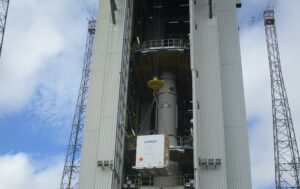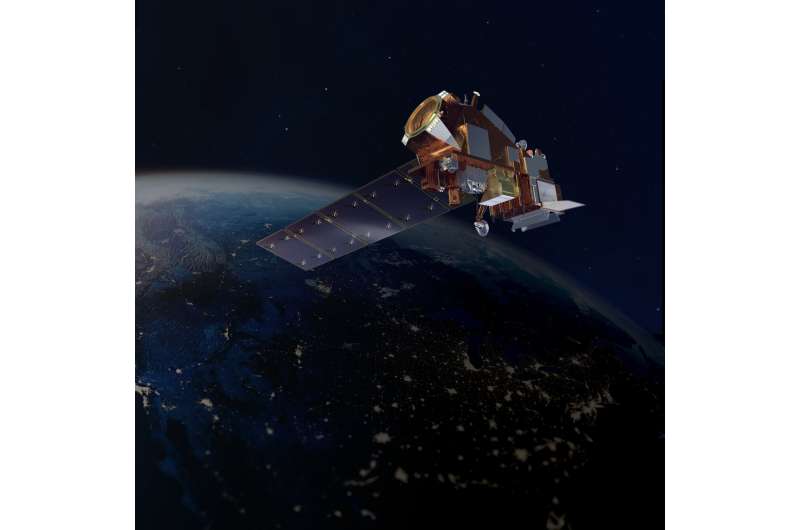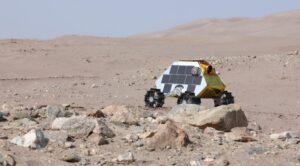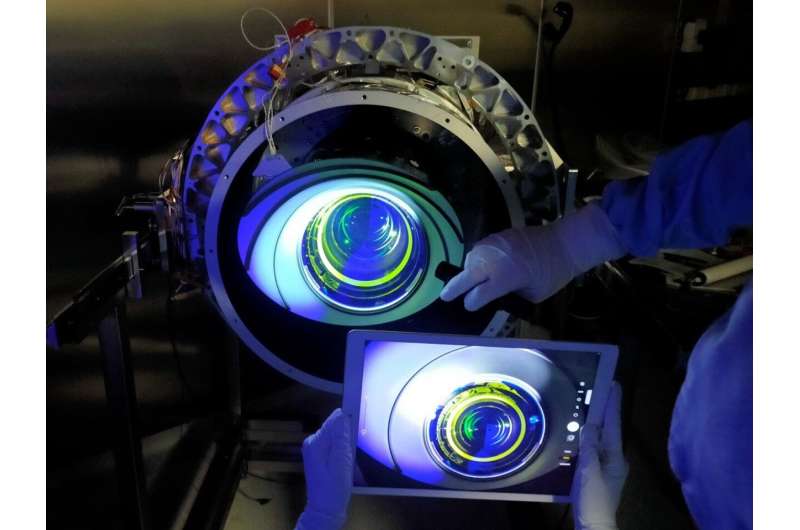Avio Q&A: Powering the growth trajectory
Wednesday, 01 June 2022 12:22
SpaceNews interviews Avio CEO Giulio Ranzo as the rocket maker is just weeks away from Vega C’s debut. Avio is also ramping up production of boosters to meet Amazon’s colossal Ariane 6 order, and could potentially accelerate the development of the next-generation Vega E as Russia’s war in Ukraine threatens suppliers.
NASA eyes November for launch of NOAA's JPSS-2
Wednesday, 01 June 2022 11:31
NASA and the National Oceanic and Atmospheric Administration (NOAA) are now targeting Nov. 1, 2022, as the new launch date for NOAA's Joint Polar Satellite System-2 (JPSS-2) satellite mission. During recent tests of a key instrument designed to collect visible and infrared images, the team found and corrected an issue, which resulted in additional time needed to complete thermal vacuum testing.
The Visible Infrared Imaging Radiometer Suite instrument, or VIIRS, experienced a test equipment issue during thermal vacuum testing. Engineers determined the issue was the result of the movement of test equipment caused by temperature fluctuations during the test. After modifying the test set up, the team retested the system, and it demonstrated excellent performance.
JPSS-2, the third satellite in the Joint Polar Satellite System series, is scheduled to lift off from the Vandenberg Space Force Base in California, on a United Launch Alliance (ULA) Atlas V rocket.
Mitsubishi Electric develops innovative laser comms terminal
Wednesday, 01 June 2022 10:53 Mitsubishi Electric has developed the prototype of what is believed to be the world's first* optical receiver for use in laser communication terminals (LCTs), that integrates space optical communication using laser beams and a function to detect the direction of received beams in the 1.5-um band, a general-purposeband used for terrestrial optical fiber communications and other applications.
Mitsubishi Electric has developed the prototype of what is believed to be the world's first* optical receiver for use in laser communication terminals (LCTs), that integrates space optical communication using laser beams and a function to detect the direction of received beams in the 1.5-um band, a general-purposeband used for terrestrial optical fiber communications and other applications. Startups raise millions for lunar rovers and asteroid mining
Wednesday, 01 June 2022 10:53
Two startups recently raised a combined $25 million in seed rounds to advance plans for lunar and asteroid missions, showing continued interest in space startups despite broader market uncertainty.
The post Startups raise millions for lunar rovers and asteroid mining appeared first on SpaceNews.
ESA conducts first tests of exoplanet hunter Plato in space-like conditions
Wednesday, 01 June 2022 08:20
Planetary Defense exercise uses Apophis as Hazardous Asteroid Stand-In
Wednesday, 01 June 2022 06:52 Watching the skies for large asteroids that could pose a hazard to the Earth is a global endeavor. So, to test their operational readiness, the international planetary defense community will sometimes use a real asteroid's close approach as a mock encounter with a "new" potentially hazardous asteroid. The lessons learned could limit, or even prevent, global devastation should the scenario play o
Watching the skies for large asteroids that could pose a hazard to the Earth is a global endeavor. So, to test their operational readiness, the international planetary defense community will sometimes use a real asteroid's close approach as a mock encounter with a "new" potentially hazardous asteroid. The lessons learned could limit, or even prevent, global devastation should the scenario play o Perseverance now selects its own targets to zap
Wednesday, 01 June 2022 06:52 Perseverance has continued into Hawksbill Gap, making remote sensing observations of small portions of outcropping rock layers in search of a good place to collect a sample. Since Perseverance is in the Shenandoah quadrangle, we are using target names from Shenandoah National Park.
Some of the names this past week included "Bald_Face_Mountain," "Little_Devil_Stairs," "Sunset_Hill," "Luck_H
Perseverance has continued into Hawksbill Gap, making remote sensing observations of small portions of outcropping rock layers in search of a good place to collect a sample. Since Perseverance is in the Shenandoah quadrangle, we are using target names from Shenandoah National Park.
Some of the names this past week included "Bald_Face_Mountain," "Little_Devil_Stairs," "Sunset_Hill," "Luck_H Asteroid Institute uses cloud-based astrodynamics platform to find and track asteroids
Wednesday, 01 June 2022 06:52NASA Moon Rover practices tricky drive off Lunar Lander
Wednesday, 01 June 2022 06:52 Once it arrives at the Moon's South Pole, NASA's Volatiles Investigating Polar Exploration Rover (VIPER) will need to perform one of the trickiest parts of its 100-day mission: driving off the Astrobotic Griffin lunar lander and onto the Moon's surface. After another successful round of testing this "egress" activity, VIPER is one step closer to being ready for launch.
VIPER has already co
Once it arrives at the Moon's South Pole, NASA's Volatiles Investigating Polar Exploration Rover (VIPER) will need to perform one of the trickiest parts of its 100-day mission: driving off the Astrobotic Griffin lunar lander and onto the Moon's surface. After another successful round of testing this "egress" activity, VIPER is one step closer to being ready for launch.
VIPER has already co A steep but short climb: Sols 3491-3492
Wednesday, 01 June 2022 06:52 Today in tactical planning I was staffed as Surface Properties Scientist, which means I get to put my geology field experience hat on and work with the rover drivers to assess the terrain we'll cross in our upcoming drive.
We'll crest onto a plateau in today's drive, but before we do, we have to finish climbing a small but steep slope. The topography today actually reminds me a little bit
Today in tactical planning I was staffed as Surface Properties Scientist, which means I get to put my geology field experience hat on and work with the rover drivers to assess the terrain we'll cross in our upcoming drive.
We'll crest onto a plateau in today's drive, but before we do, we have to finish climbing a small but steep slope. The topography today actually reminds me a little bit Gemini North Telescope Helps Explain Why Uranus and Neptune Are Different Colors
Wednesday, 01 June 2022 06:52 Astronomers may now understand why the similar planets Uranus and Neptune are different colors. Using observations from the Gemini North telescope, the NASA Infrared Telescope Facility, and the Hubble Space Telescope, researchers have developed a single atmospheric model that matches observations of both planets. The model reveals that excess haze on Uranus builds up in the planet's stagnant, sl
Astronomers may now understand why the similar planets Uranus and Neptune are different colors. Using observations from the Gemini North telescope, the NASA Infrared Telescope Facility, and the Hubble Space Telescope, researchers have developed a single atmospheric model that matches observations of both planets. The model reveals that excess haze on Uranus builds up in the planet's stagnant, sl The Sun is spinning round again
Wednesday, 01 June 2022 06:52 All was amiss with the Sun! In the early 2000s, a new set of data brought down the chemical abundances at the surface of the Sun, contradicting the values predicted by the standard models used by astrophysicists. Often challenged, these new abundances made it through several new analyses. As they seemed to prove correct, it was thus up to the solar models to adapt, especially since they serve as
All was amiss with the Sun! In the early 2000s, a new set of data brought down the chemical abundances at the surface of the Sun, contradicting the values predicted by the standard models used by astrophysicists. Often challenged, these new abundances made it through several new analyses. As they seemed to prove correct, it was thus up to the solar models to adapt, especially since they serve as Planet parade to grace the dawn sky this month
Wednesday, 01 June 2022 06:52 The delightful view of all five naked-eye planets will greet early risers throughout the month of June. While seeing two or three planets close together (in what's known as a conjunction) is a rather common occurrence, seeing five is somewhat more rare. And what's even more remarkable about this month's lineup is that the planets are arranged in their natural order from the Sun.
Throughout
The delightful view of all five naked-eye planets will greet early risers throughout the month of June. While seeing two or three planets close together (in what's known as a conjunction) is a rather common occurrence, seeing five is somewhat more rare. And what's even more remarkable about this month's lineup is that the planets are arranged in their natural order from the Sun.
Throughout MDA deploys a second set of cubesats in space
Wednesday, 01 June 2022 06:52 Building on the successful launch and deployment of its first two CubeSat Networked Communications Experiment (CNCE) Block 1 space vehicles last June, the Missile Defense Agency launched two CNCE Block 2 CubeSats May 25, 2022 aboard a SpaceX Falcon 9 rocket. Successful communications with both CubeSats was confirmed on May 31, 2022.
The new mission is a planned follow-on to the Block 1 suc
Building on the successful launch and deployment of its first two CubeSat Networked Communications Experiment (CNCE) Block 1 space vehicles last June, the Missile Defense Agency launched two CNCE Block 2 CubeSats May 25, 2022 aboard a SpaceX Falcon 9 rocket. Successful communications with both CubeSats was confirmed on May 31, 2022.
The new mission is a planned follow-on to the Block 1 suc NASA eyes November launch of NOAA's JPSS-2
Wednesday, 01 June 2022 06:52 NASA and the National Oceanic and Atmospheric Administration (NOAA) are now targeting Nov. 1, 2022, as the new launch date for NOAA's Joint Polar Satellite System-2 (JPSS-2) satellite mission. During recent tests of a key instrument designed to collect visible and infrared images, the team found and corrected an issue, which resulted in additional time needed to complete thermal vacuum testing.
NASA and the National Oceanic and Atmospheric Administration (NOAA) are now targeting Nov. 1, 2022, as the new launch date for NOAA's Joint Polar Satellite System-2 (JPSS-2) satellite mission. During recent tests of a key instrument designed to collect visible and infrared images, the team found and corrected an issue, which resulted in additional time needed to complete thermal vacuum testing. 